#Hind Bulletin
Explore tagged Tumblr posts
Text

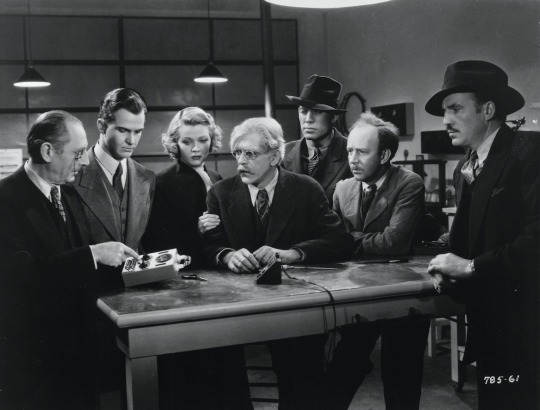



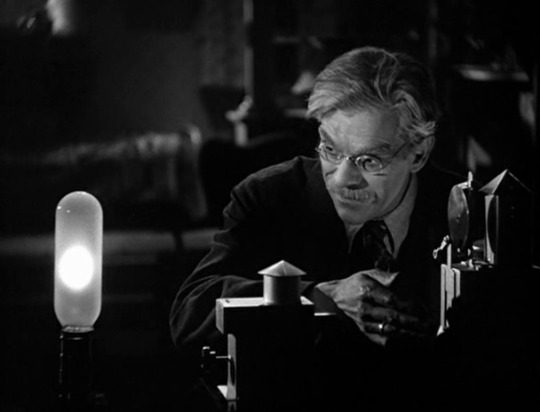

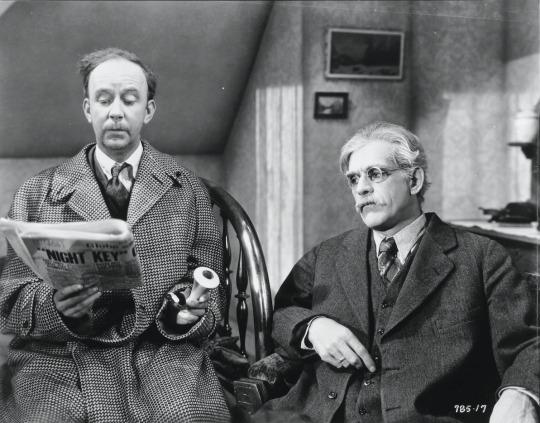
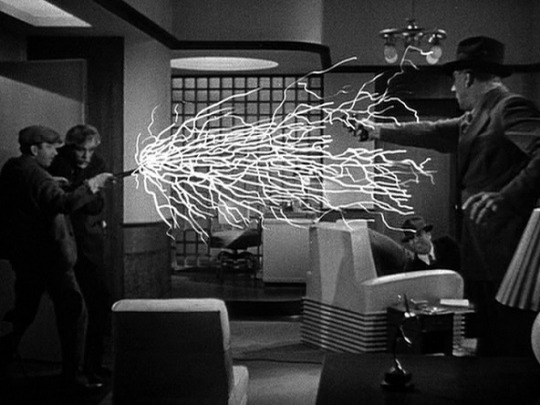
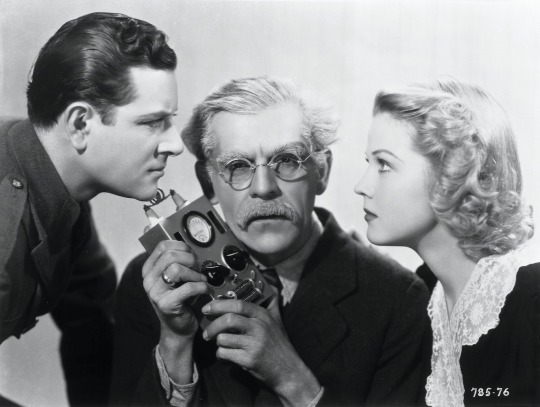
Night Key (1937)
"Now, listen, Steve. Twenty years ago you robbed me of the patent rights of the system that you're now using. Perhaps there was some excuse for that: because it gave you wealth, success, position, all the things that tempt one man to rob another. But now that you have everything and I have nothing, what possible reason is there for you to do this to me again?"
#night key#lloyd corrigan#1937#boris karloff#tristram tupper#jack moffitt#william a. pierce#warren hull#jean rogers#alan baxter#hobart cavanaugh#samuel s. hinds#david oliver#ward bond#frank reicher#edwin maxwell#george cleveland#george humbert#charles c. wilson#light hearted karloff vehicle which doesn't really deserve the sci fi label it's been given; yes‚ BK is an inventor of slightly fantastical#gadgets‚ but mostly this film is concerned with big business skullduggery with a side of organised crime. Karloff‚ as he often did‚ is#playing older than he was but he's very good and highly sympathetic as the doddery old prof. there's lots of good performances here‚ from#Jean Rogers' charming daughter to Warren Hull's romantic interest (much less tiresome than the usual role fillers in these movies) and#special mention to Hobart C as a delightfully seedy smalltime crook who attaches himself to BK like a stray dog. the only dud note is#Alan Baxter's weirdly monotone turn as the big bad‚ lacking any of the threat the character needs. the ending is twee and silly and there's#some (understandably) shaky fx work but this is genuinely a very fun time and a pleasant change from the usual Karloff vehicle of the era#one jarring moment: there's a very brief moment where a plot related news bulletin is heard on the radio‚ and as soon as it's finished the#news announcer begins to turn to the 'news from Spain' but the radio is switched off and the film moves on before we hear any more; this is#1937 remember‚ a moment of global tumult and thick in the gathering storm of the years to come but this is the only moment that the real#world is allowed to intrude into the charming and slighty silly world of eccentric inventors and sinister crooks
6 notes
·
View notes
Text
79th Batch Of Fics: 14th Fill
Shane/Pigs – cont B77F13 – Part ½ – it's like... EXACTLY what the pairing says, so don't read if you don't like :') – Female Farmer has a problem with her pigs and Mayor Lewis comes to give her a hand... (he might be the one who told Marnie only to sell her male pigs).
---
“Oh, Mayor Lewis! That’s a… surprise? And Shane too? What… I mean… uh… why?” Farmer wipes her hands on her overalls, trying to get them marginally clean before sticking one out for the Mayor to shake.
“I just saw the little outcry for help you posted on the bulletin board concerning your pigs and I thought I should come here personally to assess the situation. I might not be a farmer myself, but you know I and your dear late grandfather have been friends and I’ve picked up on some helpful tips over the years, you know?” he replies genially, wiping his hand with a handkerchief once they’re done shaking.
“That’s uh… yeah, that’s actually helpful. But why is Shane here…?”
Mayor Lewis gently starts steering the Farmer toward the pig pens where they can already hear a commotion. “Don’t worry about that, my dear. He’s just going to be my ah… assistant for today.”
“I see…” she throws Shane one last look but he’s just looking as miserable as ever, stomping after them with his gaze firmly rooted to the ground to probably make sure he’s not stepping into anything.
“You know, I’ve been like really educating myself on this stuff. I know it’s just my first year and all but I put all my money into these pigs and my pens are huge, so there shouldn’t be any problems? But for some reason they just keep fighting instead of searching for truffles. And if they don’t start soon, I think I’m gonna go bankrupt. Or something.”
They stop at the fence, watching the pigs, all three hunkering in different corners for now but looking decidedly unhappy and ready to fight at the drop of a hat.
The three of them stand there, watching them for a while before Lewis clicks his tongue and nods.
“Ah I see. I can tell you exactly where the problem lies.”
The Farmer’s head snaps around, mouth opening in a little ‘o’ of dumbfounded surprise. “You… you know? Just like that?”
He smiles like a genial old man and nods. “Oh yes. It’s pretty obvious once you know. Because, my dear-” he lifts his finger. “All these pigs are, in fact, male. They fight for territory and the right to mate.”
The Farmer’s face goes slack for a moment. She looks back at her pigs. Sure enough, all of them got fat testicles swinging between their hind legs. She hadn’t even paid any attention…
“But what am I going to do now?” she asks in a soft whisper. “I can’t believe Marnie only sold me boys…”
“Don’t you worry, my dear. That’s what Shane is here for. He’ll sort it out for you in a moment’s notice.”
.o.
“And you are sure he is okay with that? He looked a bit… apprehensive.”
“Poppycock! He’s loving it in there, don’t you see?”
“I mean… I can. That’s… whew…” she trails off, her gaze stuck on what little they can still see of Shane beneath one of her pigs. The soft muddy ground of the pen, paired with the immense weight of the animal means he is stuck deep in the mud, his belly dragging just against the ground as he is being mounted by his first suitor.
While the other two pigs are still watching, a bit unsure of what is happening but apparently more than happy to forget their little feud for the moment, the third one had waddled up to Shane as if it had known perfectly well what he was there to do.
There had been little to no hesitation from the animal to mount up and start inching closer, getting its slippery corkscrew cock to touch Shane’s hole – before glancing off again.
Still, Farmer can’t quite get over her apprehension. She leans over the fence, angling her head to try and catch Shane’s eyes. “Are you really alright? Isn’t that pig too heavy?” she asks with worry in her voice.
There’s a beat of silence. She isn’t aware of the critical stare Mayor Lewis shoots at Shane.
Shane cranes his head, peering around his bicep. His face is beet red and pears of sweat are already visible on his forehead from the strain of being underneath such a large, heavy animal.
“...It’s okay!” His voice is pressed and cracks through the last word – but that may also be simply because the pig’s cock has once again dragged across his hole in that moment.
The Farmer falls quiet again. She’s still hanging over the fence, though now she’s more watching in morbid fascination as one of her pigs keeps hunching its hips, trying to find the pussy that is on offer.
It doesn’t quite manage it for now, but she has to admit there is a certain… fascination to watching the whole thing go down. She can see glimpses of the odd wet looking cock. It’s not girthy by any means, but it is long and seems to constantly be moving; truly like some kind of screw.
She clears her throat and pulls back a little. Her thighs feel warmer than they should. To distract herself for a moment, she glances toward her other pigs. They have waddled closer, watching with interest.
Do they understand what is going to happen? They are very intelligent animals; probably the most intelligent that she has on her farm right now.
“They certainly seem more civil already,” she murmurs, chest pressed against the fence and chin on her stacked arms. One of them wanders over and she drops her hand to carefully scratch across its head. It softly chortles a few times. “Yes,” she mutters under her breath. “Much more civil. I can’t believe I didn’t notice they were all males.”
“It happens,” the Mayor interjects amiably, bouncing on the balls of his feet, thumbs stuck into his suspenders. He looks like ordering one of the townspeople to get fucked by a pig is the most normal thing to do.
“Is Shane your… assistant now or something? I think I heard someone say that they haven’t seen him in Joja Mart for ages…”
“Something like that, yes,” Mayor Lewis replies obstinately, obviously unwilling to share any more light on the confused Farmer.
He is luckily spared more probing questions as Shane cries out in that moment. Softly, somehow; it is not a sound of distress, anyway. The Farmer’s mouth closes with a click, her fingers now motionless on the pig’s head as she watches the mating proceedings in the muddy pen.
The pig finally found its hole, it seems. As she watches, it awkwardly pushes forward on its stubby legs before all but deflating as it exhales with the happy sounds of a thoroughly satisfied pig.
It does not need to move its hips to fuck the man underneath its gut, Farmer realizes, her mouth open against her forearm. Her eyes are starting to burn but she can’t make herself blink, too fascinated by the sight of Shane actually… really… undoubtedly – getting fucked by one of her pigs.
She had not imagined her morning to go this way when she woke up to tend to the crops, but she sure as Hell isn’t going to complain.
11 notes
·
View notes
Text
'I'm delighted Prince Harry's taking time off if it means he shuts up and gives us all a break!': As ANDREW NEIL launches his new TV station GB News on Sunday, he gives a refreshingly unwoke taste of what to expect
By Katie Hind Showbusiness Editor For The Mail On Sunday - June 12th 2021, 10:02:03 pm
Neil - who is critical of the BBC and Sky News - says UK viewers are subjected to bulletins that are 'too Left-wing' and lacking in humour.
10 notes
·
View notes
Text
Nothosaurus
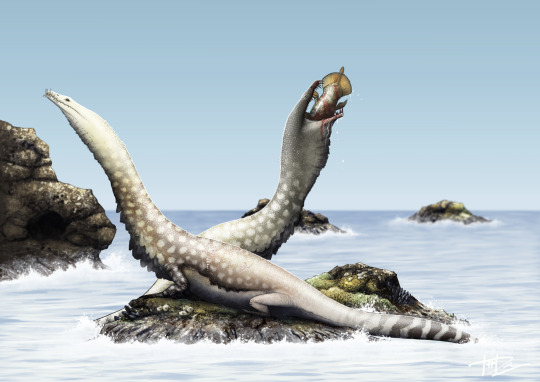
By Tas Dixon
Etymology: False Reptile
First Described By: Münster, 1834
Classification: Biota, Archaea, Proteoarchaeota, Asgardarchaeota, Eukaryota, Neokaryota, Scotokaryota, Opimoda, Podiata, Amorphea, Obazoa, Opisthokonta, Holozoa, Filozoa, Choanozoa, Animalia, Eumetazoa, Parahoxozoa, Bilateria, Nephrozoa, Deuterostomia, Chordata, Olfactores, Vertebrata, Craniata, Gnathostomata, Eugnathostomata, Osteichthyes, Sarcopterygii, Rhipidistia, Tetrapodomorpha, Eotetrapodiformes, Elpistostegalia, Stegocephalia, Tetrapoda, Reptiliomorpha, Amniota, Sauropsida, Eureptilia, Romeriida, Diapsida, Neodiapsida, Sauria, Archosauromorpha?, Archelosauria, Pantestudines, Sauropterygia, Eosauropterygia, Nothosauria, Nothosauridae, Nothosaurinae
Referred Species: N. mirabilis, N. cristatus, N. cymatosauroides, N. edingerae, N. giganteus, N. haasi, N. jagisteus, N. marchicus, N. mirabilis, N. tchernovi, N. yangjuanensis, N. zhangi
Time and Place: From 242 million years ago until 208 million years ago, from the Ladinian of the Middle Triassic through the earliest Rhaetian of the Late Triassic
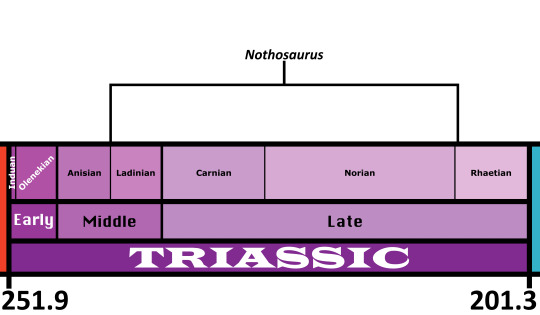
Nothosaurus is known from all over Eurasia and North Africa, to the point that it’s pointless to list all the locations. Just assume that if it’s the Mid or Late Triassic of the Tethys Sea, Nothosaurus is there.
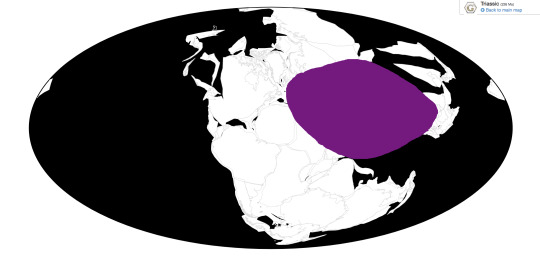
Physical Description: Nothosaurus is an iconic Triassic marine reptile - to the point that we had to include it, or else we would have violated some sort of rule of paleontology. Nothosaurus was about 4 meters long on average, but could reach up to 7 meters in length. It had a long, streamlined body, with a long neck and a long tail. Its head was narrow and filled with long and pointed teeth which interlocked together when the mouth closed, forming a tight trap. Its forelimbs were longer than its hind limbs, and all of its hands and feet had webbing between the long toes. In a lot of ways, it looked extremely similar to later marine reptiles to which it was closely related, like the Plesiosaurs and Pliosaurs, just with hands instead of proper flippers - however, current evidence indicates that the Plesiosaurs and Pliosaurs evolved from an ancestor of both groups, and Nothosaurus is just a Triassic offshoot. It had capabilities for diving in the water, though it also was still adapted for life on the shore.
Diet: Nothosaurus primarily ate fish and other marine animals, including other marine reptiles.
Behavior: Nothosaurus was semi-aquatic, spending a lot of its time both in the ocean and on land. On the beaches and shores it would rest and sleep, and then turn to the ocean for most of its everyday life. Diving for food would have been most of its daily activities, going after juvenile reptiles and large fish in the water and diving in order to reach it. It probably would have paddled with its webbed feet, and undulated its body to some extent to help propel forward. It may have been at least somewhat social, living in groups and colonizing the shores together before going for group dives for food. Interestingly enough, Nothosaurus was basically like a reptilian seal, coming up to shore to rest and sit with its relatives. Whether or not they would have given birth to live young is uncertain; while their close relatives, the Plesiosaurs, did; they retained enough land adaptations to allow them to lay eggs on the shore. More research as to their physiology is needed in order to determine that aspect of their life history. Trackways have been attributed to Nothosaurus, which may show that they rowed their paddles on the sea bed to shake up small animals trapped underneath; this would have allowed Nothosaurus to capture the invertebrates between its long teeth and hold onto them so they could not escape.
Ecosystem: Nothosaurus lived throughout the early Tethys sea, and was a common feature in many communities throughout this growing body of water during the Middle and Late Triassic. It would have stuck to the coasts for the most part, but still ventured out into deep and open water. As such, it’s rather difficult to list all the different animals it lived alongside - it’s found in Bulgaria, China, France, Germany, Hungary, Israel, Italy, Jordan, the Netherlands, Poland, Saudi Arabia, Spain, and Switzerland. So just, assume that a marine creature from the Tethys during this time lived with Nothosaurus rather than not.
Other: Nothosaurus has been treated as, unfortunately, a wastebasket taxon - it was discovered early enough in the history of paleontology as a science that many similar animals were just dumped into this name without any specific studies done. So, determining the factual relationships from this mess is still being worked out; in fact, it seems that this genus is paraphyletic, with many close relatives of Nothosaurus being more closely related to some species than to others. So that’s fun!
Species Differences: The varying species of Nothosaurus tend to differ based on where and when they lived, rather than any particularly notable differences. There are some differences in size and limb proportions as well, but in general the differing species of Nothosaurus would have had very similar ecological roles.
~ By Meig Dickson
Sources Under the Cut
Albers, P. C. H., and O. Rieppel. 2003. A new species of the sauropterygian genus Nothosaurus from the Lower Muschelkalk of Winterswijk, The Netherlands. Journal of Paleontology 77(4):738-744.
Albers, P. C. H. 2005. A new specimen of Nothosaurus marchicus with features that relate the taxon to Nothosaurus winterswijkensis. Vertebrate Palaeontology 3 (1): 1- 7.
Brotzen, F. 1956. Stratigraphical studies on the Triassic vertebrate fossils from Wadi Raman, Israel. Arkiv foer Mineralogi och Geologi 2(9):191-217.
Chrzastek, A. 2008. Vertebrate remains from the Lower Muschelkalk of Raciborowice Górne (North-Sudetic Basin, SW Poland). Geological Quarterly 52:225-238.
Diedrich, C. 2009. The vertebrates of the Anisian/Ladinian boundary (Middle Triassic) from Bissendorf (NW Germany) and their contribution to the anatomy, palaeoecology, and palaeobiogeography of the Germanic Basin reptiles. Palaeogeography, Palaeoclimatology, Palaeoecology 273 (1): 1 - 16.
d'Orbigny, A. 1849. Cours Élémentaire de Paléontologie et de Géologie Stratigraphiques [Elementary Course in Paleontology and Stratigraphic Geology] 1:1-299.
Haas, G 1980. Ein Nothosaurier-Schädel aus dem Muschelkalk des Wadi Ramon (Negev, Israel). Annalen des Naturhistorischen Museums in Wien 83:119-125.
Haines, Tim, and Paul Chambers. The Complete Guide to Prehistoric Life. Pg. 64. Canada: Firefly Books Ltd., 2006
Hinz, J. K., A. T. Matzke, and H.-U. Pfretzschner. 2019. A new nothosaur (Sauropterygia) from the Ladinian of Vellberg-Eschenau, southern Germany. Journal of Vertebrate Paleontology.
Jiang, W.; Maisch, M. W.; Hao, W.; Sun, Y.; Sun, Z. 2006. Nothosaurus yangjuanensis n. sp. (Reptilia, Sauropterygia, Nothosauridae) from the middle Anisian (Middle Triassic) of Guizhou, southwestern China. Neues Jahrbuch für Geologie und Paläontologie, Monatshefte. 5: 257–276.
Jiang, D.-Y., L. Schmitz, R. Motani, W.-C. Hao, and Y.-L. Sun. 2007. The mixosaurid ichthyosaur Phalarodon cf. P. fraasi from the Middle Triassic of Guizhou Province, China. Journal of Paleontology 81(3):602-605.
Klein, N. and P. C. H. Albers. 2009. A new species of the sauropsid reptile Nothosaurus from the Lower Muschelkalk of the western Germanic Basin, Winterswijk, The Netherlands. Acta Palaeontologica Polonica 54(4):589-598.
Lin, W.-B.; Jiang, D.-Y.; Rieppel, O.; Motani, R.; Ji, C.; Tintori, A.; Sun, Z.-Y.; Zhou, Min 2017. A new specimen of Lariosaurus xingyiensis (Reptilia, Sauropterygia) from the Ladinian (Middle Triassic) Zhuganpo Member, Falang Formation, Guizhou, China. Journal of Vertebrate Paleontology 37 (2): e1278703.
Liu, J. 2014. A gigantic nothosaur (Reptilia: Sauropterygia) from the Middle Triassic of SW China and its implications for the Triassic biotic recovery. Scientific Reports 4: 7142.
Lu, H., D.-Y. Jiang, R. Motani, P.-G. Ni, Z.-Y. Sun, A. Tintori, S.-Z. Xiao, M. Zhou, C. Ji and W.-F. Fu. 2018. Middle Triassic Xingyi Fauna: Showing turnover of marine reptiles from coastal to oceanic environments. Palaeoworld 27(1):107-116.
Münster, G. G. 1834. Preliminary news about some new reptiles in the shell limestone of Baiern. New Yearbook for Mineralogy, Geognosy, Geology and Petriology 1834 : 521-527.
Palmer, D. ed. 1999. The Marshall Illustrated Encyclopedia of Dinosaurs and Prehistoric Animals. London: Marshall Editions. p. 72.
Rieppel, O., and J.-M. Mazin. 1997. Speciation along rifting continental margins: a new nothosaur from the Negev (Israel). Comptes rendus de l'Académie des Sciences Série IIA, Sciences de la Terre et des planètes 326:991-997.
Rieppel, O. 2001. A new species of Nothosaurus (Reptilia: Sauropterygia) from the Upper Muschelkalk (Lower Ladinian) of southwestern Germany. Palaeontographica Abteilung A 263:137-161.
Sepkoski, J. J. 2002. A compendium of fossil marine animal genera. Bulletins of American Paleontology 363:1-560.
#nothosaurus#nothosaur#sauropterygian#triassic#triassic madness#triassic march madness#prehistoric life#paleontology
308 notes
·
View notes
Text
Silesaurus opolensis

By José Carlos Cortés
Etymology: Silesian Reptile
First Described By: Dzik, 2003
Classification: Dinosauromorpha, Dinosauriformes, Dracohors, Silesauridae, Sulcimentisauria
Time and Place: Around 230 million years ago, in the Carnian of the Late Triassic
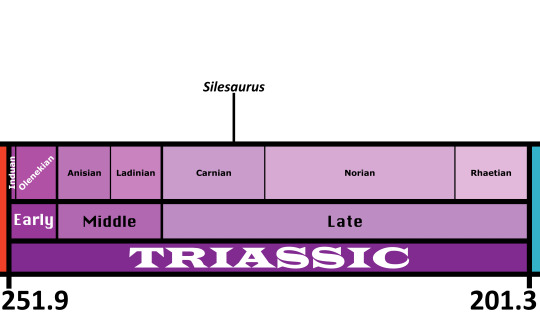
Silesaurus is known from the Drawno Beds Formation of Poland

Physical Description: Silesaurus was a very common almost-dinosaur - specifically, the titular member of the Silesaurids - from Poland in the middle of the Triassic period. It was a quadrupedal animal, about 2.3 meters long and small enough that it most likely would have been covered in fluff. Like other Silesaurids, it was long - with a long neck and a long tail, and long limbs easily reaching to the ground. Like other Silesaurids, it almost had its legs directly underneath its body - it didn’t seem to have an open acetabulum, but rather a partially open one, though Silesaurids are something of a confusing case on this regard. It had a small head, with a little beak in the front, and small sharp conical teeth. In addition, it had very large eyes, giving it distinctly good eyesight, as well as a decent sense of smell. As a quadruped, its front limbs were rather extended, while the hind limbs did a lot of the weight support.
Diet: Interestingly enough, though for a long time it was thought that Silesaurus was an herbivore, recent fossil poop studies have indicated it was an insectivore - similar to living birds.
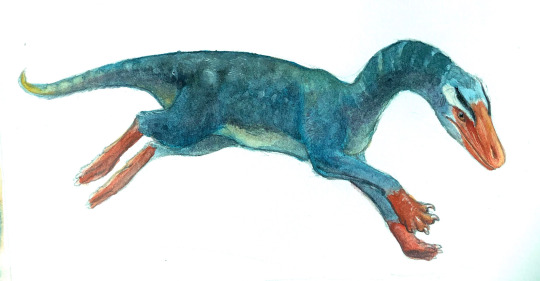
By Ripley Cook
Behavior: If Silesaurus really was an insectivore, it would have spent much of its time moving around in its environment, examining it closely for insects and pecking at the ground with its small beak for food. This pecking may have even looked a lot like that of living birds - the large eyes probably would have prevented the eyes from moving much, like in living birds, and as such Silesaurus would have had to bob its head in order to see. It would have been very careful in its environment, making sure to look for food and avoid predatory dangers in its environment. It would probably have been social - corroborated by the fact that it was very common in its environment - and taken care of its young to some extent. As an Archosaur, it would have been warm blooded as well, and very active.
Ecosystem: Silesaurus lived in a Mediterranean-esque scrub environment, with summer monsoon seasons and dry winters. The swampy coniferous forest and fernlands it lived in had a wide variety of animals, placing Silesaurus in a unique ecosystem of the Carnian age. This is actually quite important, given that the Carnian Pluvial Event - a minor mass extinction that helped to spur Dinosaurian evolution - occurred around the same time, leading to Silesaurus and its contemporaries being a snapshot of this change. A variety of invertebrates lived alongside this animal, giving it plenty of food, as well as Temnospondyls such as Metoposaurus and Cyclotosaurus, the Aetosaur Stagonolepis, the Phytosaur Parasuchus, the Rauisuchid Polonosuchus, the Sharovpterygid Ozimek, and probably some Tuataras and maybe even a Pterosaur. A small community, but a beautiful portrait of this time period, with its fair share of weirdos and precursors. And Silesaurus would have had a lot to look out for with Polonosuchus at just the right size to attack it.
Other: Do not let Silesaurus’s weird similarities to birds fool you - it wasn’t an early bird, but a showcase of how bird-like traits kept popping up over and over again in the line of animals leading up to them. In fact, the evolution of such a specialized feeding system is notable in such an early member of the Ornithodirans. Silesaurids in general are extremely interesting because of their mixture of characters - similar to dinosaurs, but not quite there; with legs almost directly underneath the body, but other traits that match the later Ornithischians. The problem with Ornithischians - the bird-hipped dinosaurs - is that they have a bit of a ghost lineage, aka even though they should have showed up at the same time as Theropods and Sauropodomorphs, they don’t until the Early Jurassic. This isn’t as big of a gap as some other examples, but it is notable. Silesaurids have come out as Ornithischians just enough times in phylogenetic studies to bring it up as a question - are they almost-dinosaurs? The first bird-hips (without having bird-hips)? Something else entirely? More research is necessarily, but one thing is for sure - this group of weird dinosaurian experiments is one to keep an eye on, especially as we learn more and more about them.
~ By Meig Dickson
Sources Under the Cut
Cau, A. 2018. The assembly of the avian body plan: a 160-million-year long process. Bollettino della Società Paleontologica Italiana 57 (1): 1 - 25.
Dzik, J. 2003. A beaked herbivorous archosaur with dinosaur affinities from the early Late Triassic of Poland. Journal of Vertebrate Paleontology 23(3):556-574.
Dzik, J. and T. Sulej. 2007. A review of the early Late Triassic Krasiejów biota from Silesia, Poland. Palaeontologia Polonica 64:3-27.
Ezcurra, M. D. 2006. A review of the systematic position of the dinosauriform archosaur Eucoelophysis baldwini Sullivan & Lucas, 1999 from the Upper Triassic of New Mexico, USA. Geodiversitas 28(4):649-684.
Griffin, C. T., and S. J. Nesbitt. 2016. The femoral ontogeny and long bone histology of the Middle Triassic (?late Anisian) dinosauriform Asilisaurus kongwe and implications for the growth of early dinosaurs. Journal of Vertebrate Paleontology 36(3):e1111224:1-22.
Irmis, R. B., S. J. Nesbitt, K. Padian, N. D. Smith, A. H. Turner, D. T. Woody, and A. Downs. 2007. A Late Triassic dinosauromorph assemblage from New Mexico and the rise of dinosaurs. Science 317:358-361.
Jagt, J. W. M., G. Hebda, S. Mitrus, E. Jagt-Yazykov, A. Bodzioch, D. Konietzko-Meier, K. Kardynał, K. Gruntmejer. 2015. Field Guide, Conference Paper, European Association of Vertebrate Palaeontologists XIII Annual Meeting.
Kammerer, C. F., S. J. Nesbitt, and N. H. Shubin. 2012. The first basal dinosauriform (Silesauridae) from the Late Triassic of Morocco. Acta Palaeontologica Polonica 57(2):277-284.
Langer, M. C., M. D. Ezcurra, J. S. Bittencourt and F. E. Novas. 2010. The origin and early evolution of dinosaurs. Biological Reviews 85:55-110.
Martínez, R. N., and O. A. Alcober. 2009. A basal sauropodomorph (Dinosauria: Saurischia) from the Ischigualasto Formation (Triassic, Carnian) and the early evolution of Sauropodomorpha. PLoS ONE 4(2 (e4397)):1-12.
Martz, J. W., and B. J. Small. 2019. Non-dinosaurian dinosauromorphs from the Chinle Formation (Upper Triassic) of the Eagle Basin, northern Colorado: Dromomeron romeri (Lagerpetidae) and a new taxon, Kwanasaurus williamparkeri (Silesauridae). PeerJ 7:e7551:1-71.
Nesbitt, S. J., C. A. Sidor, R. B. Irmis, K. D. Angielczyk, R. M. H. Smith and L. A. Tsuji. 2010. Ecologically distinct dinosaurian sister group shows early diversification of Ornithodira. Nature 464:95-98.
Nesbitt, S. J. 2011. The early evolution of archosaurs: relationships and the origin of major clades. Bulletin of the American Museum of Natural History 353:1-292.
Qvarnström, M., J. V. Wernström, R. Piechowski, M. Tałanda, P. E. Ahiberg, G. Niedźwiedzki. 2019. Beetle-bearing coprolites possibly reveal the diet of a Late Triassic dinosauriform. Royal Society Open Science 6 (3): 181042.
#silesaurus#silesaurus opolensis#dinosauromorph#palaeoblr#triassic#triassic madness#triassic march madness#prehistoric life#paleontology
244 notes
·
View notes
Photo

“I have been asked to speak up for democracy. I can only talk as one downeaster to another...”
When asked several times, in 1941, by the Harvard Alumni paper to express his opinion about the U.S. reluctance to enter WW2, Waldo, WW1 hero, wrote this essay. It is a reflection from a great, gentle mind, in a dangerous time, that shows us that there is nothing new under the sun. Democracy must always be fought for.
WALDO PEIRCE ON DEMOCRACY
I hope this does not sound like a speech. I am only writing it out under an apple tree in full bloom by the sea—never was a finer spring down here or a sicker world beyond. I should like to be painting that tree, but I have been asked to speak up for democracy. I can only talk as one downeaster to another...
This war is not like other European wars in which a pink country on a map wants some of the yellow part alongside. It is a world battle of dictatorship versus democracy; and if we wish to preserve our democracy, all the wishful thinking in the world won't keep us out of it.
What are some people trying to sell us with their “America First” syrup? It might just as well be “America Next” or “America Last” or “America Alone”—the lone last to stand against the tide. In Spain I once saw a gypsy toothpuller at a fair on his platform proclaiming painless extraction of the teeth. He got one old peasant up with one good tooth left—one good enough to get a good hold of, and out she came. Holding up the bloody tooth, he yelled: “He doesn't feel a thing.” It was true—the old peasant was out cold in his chair. Let democracy keep what teeth she has and sow them when she has to.
As for pure or superior races, have there been any since Adam and Eve in the Garden of Eden? Our strength is our very mixture of blood.
Our State of Maine . . . called vacationland by chambers of commerce . . . is an isolated one in relation to other states, whence its offering of vacation: woods, lakes, seashore, sailing and hunting, etc . . . I went fishing the other day; and paddling round a peaceful lake it seemed remote, and yet I knew it was true that somewhere thousands were in concentration camps under the new order in Europe . . . I have not been fishing since and I'll admit I was troubled. Where is vacationland today in Europe? And how long will we be a vacationland?
Our democracy is more gravely threatened every day. Our ideas of humanity and tolerance will all go down if we can't get up on our hind legs and do something about it. Our country is a soft country when it comes to everyday civic or federal responsibility. We pass the buck to some of our politicos, senators, and representatives and heaven only knows what we think of some, while we go fishing or hunting. A democracy is never prepared for anything in particular or armed to the teeth ... its casualties are 400 dead over the weekend holiday — pleasure seeking, not fighting for anything. We accept this with a shrug if it doesn't hit us or our families or familiars. We preserve the game and the wildfowl in the spring to kill more in the fall.
Democracies are full of inconsistencies of a tolerant kind. Under dictators they have an open season on political opponents and shoot them not only on the sit but in bed. It doesn't take much of a brain to know what Hitlerism stands (for). It’s everything that we as a whole don’t stand for.
I think this is a fine and generous land, an hospitable land, a democratic land and one well worth fighting for… never was a land which asked so little of the individual and gave so much.
Waldo Peirce
Source: Harvard Alumni Bulletin, Volume 43, Issue 18, 1941
18 notes
·
View notes
Note
Imagine Judy trying to do a school talent show
Barley waited ten minutes outside the elementary school, but Judy didn't appear outside. Curious, Barley went into the school to find her. It didn't take long to find Judy staring up at a bulletin board. "Your ride is here, good Judith."
Judy reared back in her hind legs as she got startled a bit. "Oh, hi Barley."
"Whatcha looking at?" Barley saw the usual announcements and lunch menu, then he saw the sign up for the school talent show. "You want to try out?"
Judy looked down at her hooves. "No."
"Then why were you looking at it?" Barley asked.
Judy sighed. "Ian has magic, and you're an adventurer. I don't have anything special."
Barley knelt down to Judy's level. "That's not true, you're great at catching bugs, and I swear you're running faster every day... though that isn't really a talent for a talent show." Barley hummed to himself in thought. "Say, you like to sing along to those songs in your Pretty Centaurs videos."
Judy replied sheepishly. "Yeah?"
"Why don't you try singing?" Barley suggested.
Judy didn't respond at first. "I dunno..."
"Okay, if you had to pick a song to sing in front of your school, what would it be?" Barley asked Judy.
Judy was quiet, just shrugged her shoulders and looked at her hooves.
"Judy?" Barley asked again.
Judy asked, "Do I have to?"
"Well if you didn't want to show off a talent," Barley asked, "why were you looking at the sign up sheet?"
Judy replied, not looking up. "I dunno."
Barley thought again. "Look, if you don't want to sing for the school, at least sing for me. It's just me, so I'll like it regardless. It's no pressure. We'll even do it in Guinevere so no one can hear."
Judy's face finally lit up. "Guinny?"
"Yeah, Guinny! She's waiting for us!"
Judy raced to the front of the school, Barley chasing after her. They made it to the van, Judy hopped into the passenger seat that was pushed far back as possible. Barley caught his breath as he backed out and drove the two of them to a park. Barley parked the two of them in a part of the parking lot where there were no cars around.
Barley pulled his janky smart phone out of his pocket. "Okay, what song did you like to sing?" he asked, pulling up his music app.
Judy grew quiet again, but responded. "How Far I'll Go."
"Moana, nice choice." Barley searched the app for an instrumental karaoke version of the song. He pressed play, causing Judy to shrink into her seat. Barley placed a comforting hand on her shoulder. "Don't be scared, it's just me."
Judy didn't want to sing, but when she heard her cue, she quietly began. It started as a whisper, Barley could barely hear her. By the first verse, Judy's voice grew to a quiet volume, but Barley could make out the words. He grew proud to see Judy finally sit up straight, break out of her shyness. But was amazed, towards the end of the song, Judy closed her eyes, sang as strong as she could. It's as if she was coming out of her shell, she was singing from her heart.
The song ended, and Barley applauded with a wide smile. "Wow, that's great!"
Judy grew shy again, but a smile grew on her face. "Really?"
"You know, if you want to do the talent show, we can always sign up tomorrow," Barley thought aloud. "Why don't we go for a little drive? Explore the neighborhood, maybe pick up some ice cream-"
Judy was the most excited she was all day. "Ice cream!"
Barley laughed as he started the car. "That's my girl!"
Barley and Judy drove down to the ice cream shop, Judy picked up chocolate on a cone with sprinkles, while Barley got a pint of mint chocolate chip. After enjoying their ice cream, the two just drove aimlessly through the suburbs for a while. Every once in a while Barley would play the instrumental track, and Judy would sing along, becoming less shy with each replay. Barley played the song at least three more times before he decided it was time to head home.
youtube
7 notes
·
View notes
Text
Runnin’ Just In Case - a.i. (1)

Summary: It wasn’t love he was chasing, but he’s running just in case.
Rating: PG-13
Warnings: swearing
Words: 1.5k
Special shoutout to @dontdoitluke for helping me with this fic
Ashton arrived in Bishop, Oklahoma with nothing but a duffle bag to his name. He hitched a ride from Dickinson, North Dakota with a trucker he met at Tesoro Big Chief. “Thanks for the ride, Jimmy.” Ashton grinned at the bearded man.
“No problem, son. You be careful out here.”
“Of course. Tell your wife I said ‘thanks for those delicious cookies.’” Ashton chuckled and pulled his duffle bag from beneath the seat.
“Mona will be delighted.” Jimmy grinned down at Ashton. “I hope you find what you’re looking for here.”
“Me too, Jimmy. Me too..” Ashton’s smile faltered slightly as he closed the door. He wandered down the road, finding an old library. He stepped inside and was thoroughly impressed by how modern the building was for such a run down town. He sat down at one of the open desktops and pulled up Craigslist, searching for a truck. When he found a suitable option, he put in an offer and got a ride to the owner’s farm a few miles away.
“You Ashton?” The farmer asked, standing next to the truck.
“That’s me. Pleasure to meet you, sir.” Ashton nodded, shaking the man’s hand.
“Where’s that accent from, boy?” The farmer asked, crossing his arms.
“Australia. But, I was raised here in the states.” Ashton explained briefly.
“What brings to these parts?” He asked, leaning against the truck.
“Just needed a fresh start.” Ashton sighed.
“Well, your offer is above what I asked for this ol’ thing.”
“Yeah, I’m a bit desperate.” Ashton chuckled. “So, what do you say?”
“You got it in cash?” The farmer asked and Ashton nodded.
“Then, I accept. Leave your information and I’ll have the title transferred in the morning.”
“Thank you so much, sir.” Ashton grinned, opening his duffle bag. He pulled out a wad of cash and handed it to the farmer. “There’s $8,000 there.” The farmer took the cash and handed Ashton the keys.
“Tank is full and the oil was just changed.”
“That’s wonderful. Any chance you know where I can find a place to stay tonight? Maybe a job, too?”
“Of course! There’s a motel back in town, right next to the Tastee-Freez. They have a bulletin board for job openings.”
“That’s perfect. Thank you so much.” Ashton grinned. He wrote down all of the necessary information before heading back into town. He found the motel and bought himself a room, immediately falling asleep.
~~~ Ashton woke up early the following morning and stood in front of the bulletin board. “Looking for a job?” Ashton perked up when he heard a voice next to him.
“Uh, yeah. I just got into town and I’m looking to settle down here.” Ashton nodded.
“Well, Evelyn Garrison has been looking for a live in ranch hand since her husband died. The pay isn’t that great, but the ranch is beautiful.”
“How long has the job been open?” Ashton asked.
“Husband’s been dead almost 10 years, but she’s really only been struggling the last few years.”
“Oh..” Ashton mused, pulling down the flyer. “Than-” he turned to face the stranger, but he found himself alone in the motel foyer. He furrowed his eyebrows and lugged his duffle to his new old truck and got in. He typed the address of the ranch into his phone and drove down the winding gravel roads.
~~~
The ranch was about an hour from town and on a large plot of land. He parked his truck and looked down at the three dogs getting on their hind legs to look at him. “Great, dogs.” Ashton muttered and got out of the truck. He knelt down and let the dogs crowd around him, just smelling him. “I promise I can smell better.” Ashton said, his eyebrows instantly furrowing. “Why am I telling you that? You’re dogs. You don’t care.”
“Excuse me, but can I ask why you’re telling my dogs that you can smell better?” Ashton looked up from his place on the dirt.
“Uh, I’m Ashton Irwin. I’m here to see if your ranch hand position is still open.” He said, standing up quickly.
“Yes! Praise the Lord. I’m Evelyn, the owner of this ranch.” She said, holding her hand out to Ashton. He shook it firmly and smiled at her.
“It’s a pleasure to meet you, Ma’am.”
“Please, call me Evelyn. Or Lynn.” Evelyn smiled. “Well, come on inside and we’ll talk about what the job entails.” Ashton nodded and followed her into the large ranch house. He followed her to the kitchen and took a seat at the island.
“You have a beautiful home. I love the rustic character with modern finishes.” Ashton smiled and looked around.
“Thank you. My husband did all of the remodels himself before he passed.” Evelyn smiled sadly and sat across from Ashton.
“I’m terribly sorry for your loss.” Ashton sighed softly and looked at her.
“Thank you.” She nodded solemnly. “Anyways, have you worked in farming before?”
“I have. I grew up in New Salem, North Dakota with my aunt and uncle on their farm.” Ashton nodded.
“The Australian accent?”
“Born in Australia and lived there for 4 years.” He said and Evelyn nodded.
“Why’d you leave New Salem?” She asked.
“I was looking for a fresh start as far from home as possible.” He shrugged and Evelyn nodded again.
“Well, you won’t be working alone. I spend most days out in the fields, my daughter takes care of the livestock, and we have three part time ranch hands who help out when needed. You’ll mostly be helping me in the fields or helping the boys.”
“That sounds great. When do you need me to start?”
“Right away. We’ll give you a couple weeks to make sure this is what you want to do. If it’s not, you can leave without losing anything. However, once you commit to this and then decide you want to leave, you’ll have to give me at least a 2 week notice.”
“I’m sure I’ll be staying here for a long time.” Ashton smiled softly at her.
“I hope so.” Evelyn smiled. “My daughter and the boys should be in any minute. They went on a ride down to the river. Feel free to look around while you wait, I’m going to get started on dinner.”
“Do you need any help?”
“No, but thank you.” Evelyn smiled and opened the fridge. Ashton smiled and stood up, walking slowly out of the kitchen. It didn’t take long for the four to return to the ranch.
“If you ever fucking touch my horse while I’m riding side saddle again, I will literally cut your fingers off and make you eat them.” Ashton’s head whipped around at the threat he heard.
“What’s going on?” Evelyn asked, looking toward the front door where they had walked in.
“Mike fucking slapped Princess’s ass while I was riding side saddle. He bucked me off and I could have died.”
“Bethany, stop being fucking dramatic! The worst that might have happened is a broken bone.” Mike laughed.
“I’m gonna give you more than a broken bone.” Bethany mumbled, going into her bedroom and slamming the door.
“Bethany Anne Garrison, what have I told you about slamming doors in my house?” Evelyn called to her.
“You didn’t have to slap Princess, you know.” The other blond sighed.
“She needed to get bucked off. It was her turn.” Mike shrugged and walked into the kitchen. “Who’s the new guy?”
“This is Ashton. He’s going to be the full time ranch hand.” Evelyn smiled. “Ashton, these are Michael, Calum, and Luke. The one that stormed off is my daughter, Bethany.”
“Pleasure to meet you guys.” Ashton smiled.
“Oof, what a hunk.” Calum chuckled. “That’s a nice accent.”
“Thanks, I got it from my mum.” Ashton laughed. He turned and looked toward the hallway as Bethany walked into the kitchen with a cat on her hip like a baby.
“Has anyone seen Calum’s bottle? It’s not in the mini fridge.” Bethany sighed. The cat in her arms meowed sadly and climbed up onto her shoulder.
“Yeah, it’s in the regular fridge.” Luke said, grabbing it.
“Wait, is the cat named Calum too?” Ashton asked, looking at the cat.
“Yes, unfortunately.” Calum sighed. “I told her not to name it Calum, but she insisted.”
“It’s a quality name. Besides, this cat is annoying like you are.” Bethany said, grabbing the bottle from Luke’s hand. “He’s a sick little bugger and won’t drink his milk like he’s supposed to.” She smiled and popped the small bottle into the cat’s mouth.
“We have animals named after everyone.” Evelyn says. “I’m a horse, Mike is a pig, Luke is a chicken, Calum’s a cat, and Bethany’s a llama.”
“She’s the llama that spits on you if you make eye contact.” Luke says.
“We’ll have to find something for Ashton.” Evelyn smiled. “Dinner’s almost ready. Bethany, why don’t you show Ashton around?”
“Sure!” Bethany smiled and handed the cat to Michael. “Come with me, new guy.” She smiled and walked out of the kitchen. Ashton followed her out and looked around. “So, you’ll be staying in here. You can get your stuff moved in whenever you want. You saw the kitchen already, here’s the main floor bathroom, here’s the living room, and this leads to the garage.” Bethany explained as she walked. “My room is directly across the hall from yours.”
“Well, I look forward to seeing you from across the hall.” Ashton said, immediately regretting his words. “Not in a creepy way! Just in a ‘I’ll see you around’ kind of way..” His cheeks burned as Bethany grinned at him.
“I look forward to seeing you from across the hall too.”
Tag List: @lukescherrypie @calumculture @kinglycalum @babylon-corgis @novacanecalum @lfwallscouldtalk @dontdoitluke @isabella10028 @calumamongmen @dukesnumber1 @lockthisheartinchains @bitterbethany @sublimehood @myloverboyash @ironicallyirwin @lashtoncurls @mukesreject @sanfrancjsco @boytoynamedcalum @opinionatedpisces-official @blahehblah @lukehemmings @calum-uncrowned @findingliam-o @gh0st-0f-y0u-95
Wanna be added to my tag list? Ask here!
#5sos#5 seconds of summer#ashton irwin#5sos smut#5sos imagine#5sos fic#5sos fanfic#fanfic#fanfiction#Ashton fic#my writing#5sos writing#imagines#imagine#Ashton imagine#network5sos#Calum hood#Luke hemmings#Michael clifford
59 notes
·
View notes
Text
Pia's Day
“Pst. Pia.”
Dali-daling naglakad papuntang elevator si Pia.
"Pia! Hoy!" sabi ulit ng lalaking alam niyang sumusunod na sa kanya.
At dahil hindi agad bumukas ang elevator kaya naabutan siya nito. Tumayo si Gene kahilera niya at halatang pasimple siyang tinitingnan.
"Ba't ang sungit mo?" mahinang tanong nito na para bang may ibang tao ng makakarinig sa kanila.
Pero dahil nga sila pa lang ang tao sa opisina at dahil sa tanong nito kaya lalo siyang nairita sa kasama niya.
"Ako pa ngayon ang masungit?! Eh, ikaw nga itong bigla na lang nang-iwan no'ng Biyernes? My, God! Magkaiba ba tayo ng definition ng salitang masungit o masama lang talaga ang ugali mo?!"
"Well, technically, hindi naman kasi kita sinungitan. Hindi lang kita naalalang sabihan no'ng umalis na ako agad," natatawa nitong paliwanag.
Nang makita nitong lalo siyang nagalit ay humingi na lang ito ng tawad.
"Sorry. I was just not in the good mood yesterday and the other day," sinserong sabi ni Gene.
"Obviously," tumitirik ang mga matang sagot ni Pia.
Alam naman niya kung bakit nag-iiba ang timpla ni Gene kapag nasa opisina. At hindi iyon dahil sa trabaho o dahil sa kanya.
It's because of a more personal matter.
Sitwasyon na nagagawa niyang obserbahan pero hinding-hindi niya gugustuhing itanong kay Gene.
Kahit noon pa alam ni Pia kung hanggang saan lang ang lugar niya. She was never a demanding friend and never a clingy girlfriend and yet she often finds herself being brokenhearted. Her ex-boyfriends ends up breaking up with her with random reasons she just accepted.
With her experiences, she realizes that no one will be brave enough to specify and justify what she did wrong while being in a relationship with someone. She thought, there's no such thing as being honest all the time. There's no such thing as finding out the truth, unless someone plays detective which she was never into. And it's really a lie when someone tells you they can accept everything about you. And for Pia, it's fine.
Really.
Kapag narinig niya na ang linyang, "It's not you, it's me." May sagot na agad siya na, "Oh, don't worry. I understand. So, let's break up."
Pero kapag si Eugene Torres ang kasama niya at may nagawa siyang palpak, panigurado hindi lilipas ang isang araw nang hindi niya iyon nalalaman. Ganoon rin naman kasi siya dito. Parang naging gantihan na nilang dalawa na magpagalingan at ipamukha sa isa't isa kapag may hindi nakikinig sa payo o sinabi ng bawat isa.
In a way, that made her productive and creative. Marami ang nagsasabi na para silang aso't pusa. May ilan naman na nagsasabi na baka ma-develop sila sa isa't isa, na malabong mangyari dahil alam ni Pia kung sino ang gusto ni Gene. At sa totoo lang, masuwerte ang mga babaeng nagugustuhan nito.
When he loves a woman he loves her completely. Nakita niya kung paano nito asikasuhin ang girlfriend nito noon. At kahit may ibang babaeng lumandi dito ay hindi ito pumapatol sa kahit anong biro na alam nitong puwedeng pagmulan ng gulo.
Nakita niya kung paano ito manlumo nang malaman nitong sa ibang bansa na pala planong tumira ng nobya nito na naging dahilan ng paghihiwalay ng dalawa. Hindi niya sinasadyang marinig noon ang usapan ni Gene at ng ilan nilang katrabaho. Bago pa niya malaman ang ibang detalye ay tumalikod na si Pia at lumayo sa mga nag-uusap.
A year had passed after that. At nitong nakaraang linggo nga ay nakikita ni Pia kung paano pinag-iisipan ni Gene nang mabuti kung paano manliligaw sa babaeng matagal na rin naman nitong pinagkakainteresan.
Kaya lang may nobyo na pala si Celine. Walang nakakaalam niyon hanggang sa may nagtanong noong nakaraang Biyernes habang sabay-sabay silang kumakain sa isang restaurant.
Her boyfriend is ten years older than her. At dahil hindi naman nagpo-post masyado sa Facebook si Celine kaya walang nakakapuna na may boyfriend ito.
Until Gene noticed Celine often looking at her cell phone and answering a call. Bagong empleyado rin lang kasi ito kaya wala rin halos nakakaalam ng pribadong buhay nito.
As for Gene, he never told anyone he likes Celine.
Napuna lang talaga iyon ni Pia.
Gene is a terrible liar and could not pretend he doesn't have a crush on someone. Halos manigas ito sa kinatatayuan kapag nasa malapit lang si Celine. Halos hindi na ito makatingin sa iba kapag natatanaw nito si Celine at alam nitong hindi ito makikita o mapupuna ng babae.
He is like a dog wagging his tail and often making soft whimpers while looking out the window and waiting for his owner to come home and pet him.
Ganoon ito kalala.
Pero siya lang ang nakakapuna kasi hindi naman madaldal si Gene tungkol sa mga personal na bagay at wala rin namang nakakahalata dahil lagi itong kalmado lang kung titingnan.
Sabi rin ng mga kaibigan ni Pia sadyang magaling siyang makabasa ng mga kilos ng ibang tao. Kaya nga madali niya ring nahahalata kapag makikipaghiwalay na ang karelasyon niya.
But the most awkward part is when people claim that she and Gene look good together. As a couple.
"Diyos ko kung alam n'yo lang..." minsang sagot niya ng pabulong.
Natakot si Pia nang muntikan siyang marinig ng iba nilang kasama ni Gene noon. Natakot rin siya na baka iba ang maging interpretasyon ng mga kakilala nila sa nasabi niya.
Pero kasi, nakakainis na.
Hindi niya masabi na kahit ano pang pilit ng iba na bagay sila, kahit pa ilang beses iparinig ng mga ito ang kantang may lyrics na, "Pinagtagpo pero hindi itinadhana..." Wala. Deadma sila ni Gene.
They both knew the truth even though they don't discussed it. Klarong-klaro naman kasi iyon. They can be friends but they will never be lovers.
Amen.
"O," sabi ni Gene nang makasakay na sila sa loob ng elevator.
"Ano `yan?" tanong ni Pia nang makitang may inaabot sa kanya.
"Regalo ko sa `yo."
Natawa nang mahina si Pia.
"Suhol mo sa `kin kasi hindi mo ako hinatid pauwi no'ng Friday?"
Iyon kasi ang usapan nila. Sasama sila sa dinner sa labas kasama ang mga katrabaho nila tapos sabay silang uuwi dahil mahirap sumakay sa Katipunan area at hindi niya ugali na sumakay sa taxi nang mag-isa.
"Hindi `yan suhol," seryosong sabi ni Gene habang nakalahad pa rin ang kamay nito hawak ang maliit na kahon.
"Eh, ano? Peace offering? Alay? Lagay?"
"Birthday gift," parang napipikon ng sabi nito.
Natulala si Pia.
"Paano mo nalaman?"
Imbes na sumagot ay hinawakan nito ang isang kamay niya at pabagsak na inilagay doon ang regalong kanina pa nito inaabot.
"Bulletin board," kaswal na sagot ni Gene.
Sakto naman na bumukas na ang elevator kaya nauna na itong lumabas.
Hindi na nito nakita ang pagkatulala ni Pia.
1 note
·
View note
Text
Sharovipteryx mirabilis

By @stolpergeist
Etymology: Sharov’s Wing
First Described By: Sharov, 1971
Classification: Biota, Archaea, Proteoarchaeota, Asgardarchaeota, Eukaryota, Neokaryota, Scotokaryota, Opimoda, Podiata, Amorphea, Obazoa, Opisthokonta, Holozoa, Filozoa, Choanozoa, Animalia, Eumetazoa, Parahoxozoa, Bilateria, Nephrozoa, Deuterostomia, Chordata, Olfactores, Vertebrata, Craniata, Gnathostomata, Eugnathostomata, Osteichthyes, Sarcopterygii, Rhipidistia, Tetrapodomorpha, Eotetrapodiformes, Elpistostegalia, Stegocephalia, Tetrapoda, Reptiliomorpha, Amniota, Sauropsida, Eureptilia, Romeriida, Diapsida, Neodiapsida, Sauria, Archosauromorpha, Protorosauria, Sharovipterygidae
Time and Place: 242 million years ago, in the Ladinian of the Middle Triassic

Sharovipteryx is known from the Madygen Formation of Kyrgyzstan

Physical Description: Ah Sharovipteryx. Are there many Triassic weirdos as iconic as this one? It was a weird, Archosauriform reptile, only about 25 centimeters long from snout to tail, and extremely thin - its tail is practically ephemeral, and its head is small and sharply pointed at the tip of the snout. Its body was also very skinny and almost flat, and it had short, skinny forelimbs. It’s hindlimbs were also skinny - and very, very, very long. The reason for this length is simple - the fossils show that there was a very long membrane of skin extending from the tips of the toes to the armpits, utilizing the legs as an anchor for this membrane. The skin of the hind-limbs may have been just a membrane, but Sharovipteryx did have scales like those of a lizard covering its entire body. The long and skinny tail seems to have lacked ornamentation altogether.
Diet: With small, sharp teeth, Sharovipteryx probably would have fed mainly on insects.
Behavior: Sharovipteryx was a glider, utilizing its hind limbs in a Delta-Wing formation, possibly one of the only animals - certainly one of the only known reptiles - to do so. The thin front limbs would have been like an aeronautic canard, helping the animal move with more agility in the air, and also would have been useful in steering. The tail could have been bent up and down to create drag, slowing down its movement from tree to tree. It couldn’t flap, but it wouldn’t need to, as its densely forested environment allowed it to move quickly by gliding from tree to tree and controlling pitch with its forelimbs. Sharovipteryx probably evolved from climbers, which used their ridiculous hind limbs to go up and down tree trunks; these little animals then leapt from tree to tree, and eventually developed gliding capability in the process. Sharovipteryx appears to have been relatively uncommon, so its possible it wasn’t very social; whether or not it would have taken care of its young is unknown. It probably used its small narrow head to grab food easily, though mostly it would have been decent streamlining for gliding (much like Delta-Wing Aircrafts like Viggens and Gripens).

By @stolpergeist
Ecosystem: As we’ve learned before, the Madygen was an extremely densely forested ecosystem, with thick coniferous trees packed around large lakes set in deep, clay-filled mud. This made it a very wet and green environment, without many large animals, but instead with many animals adapted for the trees and then well preserved in the extensive mud. Many different animals and insects have been preserved in this environment along with Sharovipteryx. Insects included the earliest Hymenopterans, Titanopterans like Gigatitan, moths, beetles, crickets, mosquitos, flies, grigs, and other weird insects with no modern analogues - plenty of food for Sharovipteryx. There were other vertebrates, too - sharks such as Fayolia, Lonchidion, and Palaeoxyris; ray-finned fish like Alvinia, Megaperleidus, Sixtelia, Ferganiscus, Oshia, and Saurichthys; the salamander-like Triassaurus; the primitive cynodont Madysaurus; the Drepanosaur Kyrgyzsaurus; and, of course, the great hockey-scale-creature Longisquama. Such a weird and fascinating slice of Triassic life!
Other: Sharovipteryx is classified as a Protorosaur - a group of Triassic Weirdos that are probably more closely related to Archosaurs than anything else that includes animals like the long-necked Tanystropheus, the reptile-monkeys like Drepanosaurus, and the Permian Archosauromorph (!!! big deal alert!!!) Protorosaurus. That said, this group is probably an artificial one, with these animals not actually grouped together to the exclusion of other Archosauromorphs. While relationships among the animals within the group clearly exist, it is uncertain how many of them are really grouped together. That said, weirdly enough, Tanystropheids and Sharovipteryigds do have a certain amount in common, so they might stay together yet. More study on the evolution of Archosauromorphs is, clearly, needed as we try to figure out the details of their relationships and where exactly Sharovipteryx and its cousin Ozimek go.
~ By Meig Dickson
Sources Under the Cut
Alifanov, V. R., and E. N. Kurochkin. 2011. Kyrgyzsaurus bukhanchenkoi gen. et sp. nov., a new reptile from the Triassic of southwestern Kyrgyzstan. Paleontological Journal 45(6):42-50.
Cowen, R. 1981. Homonyms of Podopteryx. Journal of Paleontology 55:483.
Dyke, G. J., Nudds, R. L. and Rayner, J. M. V. (2006). "Flight of Sharovipteryx mirabilis: the world's first delta-winged glider". Journal of Evolutionary Biology.
Dzik, Jerzy; Tomasz Sulej (2016). "An early Late Triassic long-necked reptile with a bony pectoral shield and gracile appendages". Acta Palaeontologica Polonica. 61 (4): 805–823.
Ezcurra, Martín D. (2016). "The phylogenetic relationships of basal archosauromorphs, with an emphasis on the systematics of proterosuchian archosauriforms". PeerJ. 4: e1778.
Fischer, J.; Voigt, S.; Schneider, J.W.; Buchwitz, M.; Voigt, S. (2011). "A selachian freshwater fauna from the Triassic of Kyrgyzstan and its implication for Mesozoic shark nurseries". Journal of Vertebrate Paleontology. 31 (5): 937–953.
Gans, Carl; Darevski, Ilya; Tatarinov, Leonid P. (1987). "Sharovipteryx, a reptilian glider?". Paleobiology. 13 (4): 415–426.
Ivakhnenko, M. F. 1978. Tailed amphibians from the Triassic and Jurassic of Middle Asia. Paleontological Journal 1978(3):84-89.
Nesbitt, J., Sterling; 1955-, Flynn, John J. (John Joseph); 1987-, Pritchard, Adam C.; 1953-, Parrish, J. Michael; Lovasoa., Ranivoharimanana; R., Wyss, André (2015-12-07). "Postcranial osteology of Azendohsaurus madagaskarensis (?Middle to Upper Triassic, Isalo Group, Madagascar) and its systematic position among stem archosaur reptiles. (Bulletin of the American Museum of Natural History, no. 398)".
Pritchard, Adam C.; Hans-Dieter Sues (2019). "Postcranial remains of Teraterpeton hrynewichorum (Reptilia: Archosauromorpha) and the mosaic evolution of the saurian postcranial skeleton". Journal of Systematic Palaeontology. 17 (20): 1745–1765.
Sharov, A. G. 1970. An unusual reptile from the Lower Triassic of Fergana. Paleontological Journal 1970(1):112-116.
Sharov, A. G. 1971. Novye letayushche reptilii is Mesosoya Kazachstana i Kirgizii [New Mesozoic flying reptiles from Kazakhstan and Kirgizia]. Trudy Paleontologicheskiya Instituta Akademiy Nauk SSSR 130:104-113.
SHCHERBAKOV, Dmitry (2008). "Madygen, Triassic Lagerstätte number one, before and after Sharov". Alavesia. 2 (5): 125–131.
Tatarinov, L. P. 2005. A new cynodont (Reptilia, Theriodontia) from the Madygen Formation (Triassic) of Fergana, Kyrgyzstan. Paleontological Journal 39:192-198.
Udurawane, Vasika. 2016. Sharovipteryx, the Triassic reptile with leg-wings. Earth Archives.
Unwin, D. M., V. R. Alifanov, and M. J. Benton. 2000. Enigmatic small reptiles from the Middle-Late Triassic of Kirgizstan. In M. J. Benton, M. A. Shishkin, D. M. Unwin, E. N. Kurochkin (eds.), The Age of Dinosaurs in Russia and Mongolia. Cambridge University Press, Cambridge 177-186
#sharovipteryx#sharovipterygid#archosauromorph#diapsid#triassic#triassic madness#triassic march madness#prehistoric life#paleontology
239 notes
·
View notes
Text
Helveticosaurus

By Tas Dixon
Etymology: Swiss Reptile
First Described By: Peyer, 1955
Classification: Biota, Archaea, Proteoarchaeota, Asgardarchaeota, Eukaryota, Neokaryota, Scotokaryota, Opimoda, Podiata, Amorphea, Obazoa, Opisthokonta, Holozoa, Filozoa, Choanozoa, Animalia, Eumetazoa, Parahoxozoa, Bilateria, Nephrozoa, Deuterostomia, Chordata, Olfactores, Vertebrata, Craniata, Gnathostomata, Eugnathostomata, Osteichthyes, Sarcopterygii, Rhipidistia, Tetrapodomorpha, Eotetrapodiformes, Elpistostegalia, Stegocephalia, Tetrapoda, Reptiliomorpha, Amniota, Sauropsida, Eureptilia, Romeriida, Diapsida, Neodiapsida, Sauria, Helveticosauridae
Time and Place: Around 242 million years ago, on the Anisian-Ladinian boundary of the Middle Triassic

Helveticosaurus is known from the San Salvatore Formation of Italy and the Besano Formation of Switzerland

Physical Description: Helveticosaurus is one of the weirdest of Triassic marine oddities in terms of relationships - once thought to just be one of many different turtle relatives, it now seems to be a completely separate, just outside the group containing all living reptiles swimming creature utterly removed from the rest. It was a lopsided sort of creature, about 2 meters long with a widened torso - almost circular - short neck, and long tail. Its forelimbs were much longer than its hind limbs, and the tail was thickened at the top, sort of like the tail of a marine iguana, much like the contemporaneous Thalattosaurs. The head was small and rectangular, with sharp and pointed teeth filled throughout the mouth. It was probably covered in thick scales, and the hands and feet of Helveticosaurus were probably webbed to some degree.
Diet: Given the sharp, pointy teeth, Helveticosaurus probably was a carnivore, eating a variety of fish, invertebrates, and probably its fellow marine reptiles.
Behavior: Helveticosaurus had an extremely unique method of locomotion in the water. It was able to both undulate its body - sweeping it from side to side and using the tail to move through the water like living crocodilians and marine iguanas - and paddle, propelling itself forward with grand movements of its front limbs. These limbs were well built for swimming, and if Helveticosaurus hadn’t been an evolutionary dead end, it may have had one of the more unique methods of marine movement in the oceans. As a predator, it would have needed to use its weird swimming to reach for prey that one of the many other things it lived with could not get to. It also may have been able to come up onto the shore, perhaps feeding on animals nearby or going there to mate or escape danger in the ocean. That said, there are so many questions remaining about this oddball - did it lay its legs on land or give birth like most marine reptiles? Did it live on both the land and in the ocean for any length of time? In addition to this, the strange short face may or may not have allowed Helveticosaurus to be a suction feeder, sucking up the various small animals around it and snapping into them with its long teeth. This is just extra, and I’m giving up on trying to understand this thing now. Also, it couldn’t swim very well - at least, not like modern penguins or turtles - it didn’t fly, but made a good business out of doggy paddling and brute-forcing the action, making it one hardcore badass of a reptile.
Ecosystem: Helveticosaurus lived near the Pangean coast, in the shallow marine waters of the Tethys sea. These marine habitats were probably open ocean, as little evidence of reef material is present in the same places as Helveticosaurus, though that is conjecture. Here it lived alongside a wide variety of brachiopods, as well as marine snails and Ammonites a plenty. There was also the Nothosaurs Nothosaurus and Lariosaurus; the Thalattosaurs Hescheleria, Clarazia, and Askeptosaurus; the Tanystropheids Tribelesodon Tanystropheus and Macrocnemus; the other Helveticosaurid Eusaurosphargis; the Placodonts Paraplacodus and Cyamodus; the Ichthyosaurs Cymbospondylus and Mixosaurus; the Pachypleurosaurs Serpianosaurus and Pachypleurosaurus; the Suchian Ticinosuchus; and an extremely wide variety of fish and sharks (to the point that it is literally impossible for me to list them all.)
Other: We have no idea what Helveticosaurus is. We used to think it was a generic marine reptile, maybe a Placodont. Then, perhaps, an Archosauriform. Finally, now, we place it far apart from the rest, not even a proper Crown-Reptile. Still, the story isn’t over - maybe it, along with all other uniquely marine reptiles, are in one separate group? Who knows. These things are odd. I just can’t. It had two other relatives, one not named, the other Eosaurosphargis, which was even flatter around the middle. Honestly, it looks like a more plausible and marine Godzilla, in a weird, twisted way. Here we are. Triassic, what the fuck.
~ By Meig Dickson
Sources Under the Cut
Carroll, R. L. 1988. Vertebrate Paleontology and Evolution 1-698.
Chun, L., D.-Y. Jiang, L. Cheng, X.-C. Wu, O. Rieppel. 2014. A new species of Largocephalosaurus (Diapsida: Saurosphargidae), with implications for the morphological diversity and phylogeny of the group. Geological Magazine 151 (1): 100 - 120.
Li, C., O. Rieppel, X.-C. Wu, L.-J. Zhao, L.-T. Wang. 2011. A new Triassic marine reptile from southwestern China. Journal of Vertebrate Paleontology 31 (2): 303 - 312.
Mazin, J.-M. 1981. Grippia longirostris Wiman, 1929, un Ichthyopterygia primitif du Trias inférieur du Spitsberg. Bulletin du Muséum National d'Histoire Naturelle 4: 317–340.
Motani, R. 2000. Skull of Grippia longirostris: no contradiction with a diapsid affinity for the Ichthyopterygia. Palaeontology 43: 1 - 14.
Naish, D. 2008. One of so many bizarre Triassic marine reptiles. Weblog entry. Tetrapod Zoology.
Nosotti, Stefania; Rieppel, Olivier 2003. Eusaurosphargis dalsassoi n. gen. n. sp., a new, unusual diapsid reptile from the Middle Triassic of Besano (Lombardy, N Italy). Memorie della Societa Italiana di Scienze Naturali e del Museo Civico di Storia Naturale di Milano Ile 31 (3): 1–33.
Neenan, J. M., N. Klein, T. M. Scheyer. 2013. European origin of placodont marine reptiles and the evolution of crushing dentition in Placodontia. Nature Communications 4: 1621.
Peyer, B. 1955. Die Triasfauna der Tessiner Kalkalpen. XVIII. Helveticosaurus zollingeri, n.g. N.sp. Schweizerische Paläontologische Abhandlungen 72: 3–50.
Pieroni, V., and A. Nützel. 2014. Rasatomaria gentilii gen. n. n. sp. - a new Middle Triassic pleurotomarioid gastropod genus and species from Rasa di Varese (San Salvatore Formation, southern Alps). Rivista Italiana di Paleontologia e Stratigrafia 120:281-286.
Rieppel, O. 1989. Helveticosaurus zollingeri Peyer (Reptilia, Diapsida) skeletal paedomorphosis, functional anatomy and systematic affinities. Palaeontographica Abteilung A 208:123-152.
Rieppel, O. 1998. The status of the sauropterygian reptile genera Ceresiosaurus, Lariosaurus, and Silvestrosaurus from the Middle Triassic of Europe. Fieldiana: Geology, new series 38:1-46.
Sepkoski, J. J. 2002. A compendium of fossil marine animal genera. Bulletins of American Paleontology 363:1-560.
Witton, M. 2018. Helveticosaurus: the small-headed, long-armed Triassic marine reptile that just wants to be your friend :(. Weblog Entry. Markwitton.com.
#helveticosaurus#diapsid#triassic#triassic madness#triassic march madness#prehistoric life#paleontology
182 notes
·
View notes
Text
Morganucodon
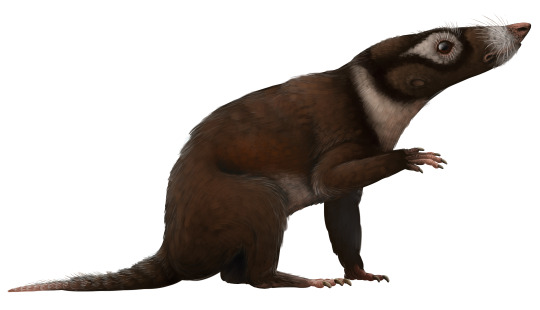
By Scott Reid
Etymology: Tooth from Glamorgan (a county in Wales)
First Described By: Kühne, 1949
Classification: Biota, Archaea, Proteoarchaeota, Asgardarchaeota, Eukaryota, Neokaryota, Scotokaryota Opimoda, Podiata, Amorphea, Obazoa, Opisthokonta, Holozoa, Filozoa, Choanozoa, Animalia, Eumetazoa, Parahoxozoa, Bilateria, Nephrozoa, Deuterostomia, Chordata, Olfactores, Vertebrata, Craniata, Gnathostomata, Eugnathostomata, Osteichthyes, Sarcopterygii, Rhipidistia, Tetrapodomorpha, Eotetrapodiformes, Elpistostegalia, Stegocephalia, Tetrapoda, Reptiliomorpha, Amniota, Synapsida, Eupelycosauria, Sphenacodontia, Sphenacodontoidea, Therapsida, Eutherapsida, Neotherapsida, Theriodontia, Eutheriodontia, Cynodontia, Probainognathia, Chiniquodontoidea, Prozostrodontia, Mammaliaformes, Morganucodonta, Morganucodontidae
Referred Species: M. watsoni, M. oehleri, M. tardus, M. peyeri, M. heikuopengensis
Status: Extinct
Time and Place: Morganucodon is known from the Kayenta Formation of Arizona, the Forest Marble Formation of England, the Varangeville Conglomerate of France, the Gruhalde Member of the Klettgau Formation of Austria, and the Lufeng Formation of Yunnan, China. Please note that only the Chinese, Austrian, and French locations are of Triassic origin.

Morganucodon lived from the Rhaetian of the Late Triassic to the Bathonian Middle Jurassic of Eurasia, from around 205 million years ago until 167 million years ago.

Physical Description: While Morganucodon itself is not known from many body fossils, its appearance can be inferred from its relatives, such as Megazostrodon, that have been better preserved. Its body would have been elongated and low to the ground, somewhat resembling a shrew. It may have sprawled somewhat with its forelimbs, but its hind legs and hips were much closer to those of mammals. Morganucodon’s skull was long and flat on top. It had two types of teeth, premolars and molars, similar to later mammals. The mammaliaform also replaced its teeth once in its lifetime: it had “baby” (or “milk”) teeth and “adult” teeth, like its modern relatives.
Diet: Morganucodon was almost certainly insectivorous. Study of its teeth showed that its jaws could stand up to more stress and that its bite was relatively forceful, allowing members of the genus to hunt “tougher” prey items than its contemporaries. It may have eaten beetles, which are known from its environment.
Behavior: These animals were probably nocturnal, as evidenced by heightened senses of hearing and smell, as well as comparisons with similar modern animals.
Ecosystem: Due to its wide distribution, Morganucodon would likely have inhabited a range of environments. The first fossils were discovered in what were once fissures on an early Jurassic or late Triassic limestone island, St. Bride’s Island. It was a small landmass of about 20 square km (7.7 square mi) with a karst environment of sinkholes and caves. It would also have been warm, supporting plants such as clubmosses, bennetites, ferns, and cycads. Morganucodon would have shared its environment with other mammaliaforms, such as Kuehneotherium, and as such likely experienced niche partitioning (different species occupying different niches in ecosystems, which reduces competition). Other animal species known from the same areas include ancient reticulated beetles, the sphenodontian Gephyrosaurus, and another mammal relative, Oligokyphus.
The Swiss fossils were unearthed in marine deposits, though it is likely that it was washed out to sea. Other terrestrial animals known from these beds include the pterosaur Peteinosaurus, the trilophosaur Variodens, a few rhynchocephalians, and several species of cynodonts. The environment of the French specimens is less well-documented, but likely similar, with therapsids, temnospondyl amphibians, pterosaurs, and phytosaurs all being documented.
Other: This small mammaliaform has helped to illuminate the evolution of mammalian ears. Our lower jaws, and those of our modern mammalian cousins, are unique in that they are made up of only one bone: the mandible. In other animals, this structure is made up of multiple different bones, which are used to help with chewing. Somewhere along the line in mammal evolution, most of our lower jaw bones shrunk in size and moved to our ears, enabling us to have a complex system of hearing. Morganucodon represents an intermediate step in this process: it still had many of the jaw bones of more basal amniotes, albeit much more reduced.
It would also likely have been warm-blooded, as evidenced by its secondary palate. This feature of the skeleton separates the nasal cavity from the mouth, allowing animals with it to quickly breathe while using their mouths for feeding. Morganucodon also had a bone structure that suggested rapid growth. Other shared traits with modern mammals include the likely presence of mammary glands and a relatively large brain.
~ By Jasper Barnes
Sources under the Cut
Benton, Michael J. (2015). Vertebrate Palaeontology (fourth edition). Wiley Blackwell.
Butler, Percy M., Sigogneau-Russell, Denise (2016). Diversity of triconodonts in the Middle Jurassic of Great Britain. Palaeontologia Polonica 67, 35–65.
Evans, S. E. (1992). Small reptiles and amphibians from the Forest Marble (Middle Jurassic) of Dorset. Proceedings of the Dorset Natural History and Archaeological Society 113:201-202
Fraser, Nicholas (2006). Dawn of the dinosaurs: life in the Triassic. Indiana University Press.
Gill, Pamela G., Purnell, Mark A., Crumpton, Nick., Robson Brown, Kate, Gostling, Neil J., Stampanoni, M., and Rayfield, Emily J. (2014). Dietary specializations and diversity in feeding ecology of the earliest stem mammals. Nature 512, 303–305
Godefroit, P. (1997). Reptilian, therapsid and mammalian teeth from the Upper Triassic of Varangéville (northeastern France). Bulletin de l'Institut Royal des Sciences Naturelles de Belgique, Sciences de la Terre 67:83-102
Peyer, B. (1956). Über Zähne von Haramiyiden, von Triconodonten und von wahrscheinlich synapsiden Reptilien aus dem Rhät von Hallau, Kt. Schaffhausen, Schweiz [On the teeth of haramiyids, triconodonts, and probable synapsid reptiles from the Rhaetic of Hallau, Kanton Schaffhausen, Switzerland]. Schweizerische Paleontologische Abhandlungen 72:1-72
Walter G. Kühne, "On a Triconodont tooth of a new pattern from a Fissure-filling in South Glamorgan", Proceedings of the Zoological Society of London, volume 119 (1949–1950) pages 345–350
#Morganucodon#Mammaliaform#Mammal#Triassic#Palaeoblr#Triassic Madness#Triassic March Madness#Morganucodon watsoni#Morganucodon oehleri#Morganucodon tardus#Morganucodon peyeri#Morganucodon heikuopengensis#Prehistoric life#Prehistory#Paleontology
178 notes
·
View notes
Text
Sauropelta edwardsorum

By Jack Wood
Etymology: Reptile Shield
First Described By: Ostrom, 1970
Classification: Dinosauromorpha, Dinosauriformes, Dracohors, Dinosauria, Ornithischia, Genasauria, Thyreophora, Eurypoda, Ankylosauria, Nodosauridae, Nodosaurinae
Status: Extinct
Time and Place: Sauropelta lived between 115 and 105 million years ago, from the Aptian to the Albian ages of the Early Cretaceous

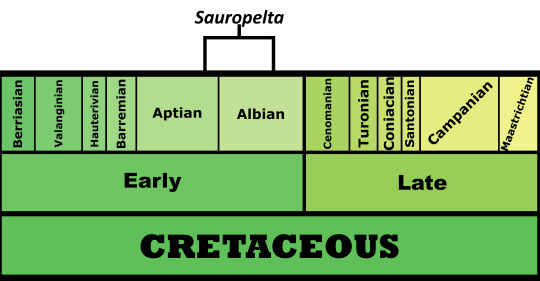
Sauropelta is known entirely from the Cloverly Formation of Montana and Wyoming, specifically the Himes and Little Sheep Mudstone Members
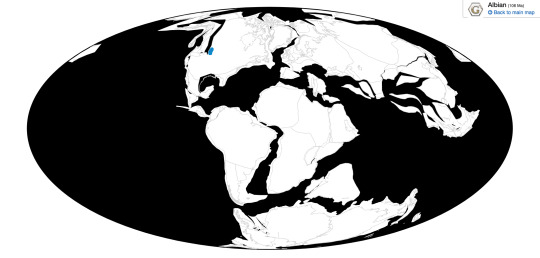
Physical Description: Sauropelta is a Nodosaurid, a kind of armored dinosaur that featured extensive spikes and other ornaments on their bodies for sexual display. It’s also one of the better known ones, due to its fairly impressive shoulder spikes. While we know the basic structure of this armor due to its bone base, relatives of Sauropelta have helped to indicate that keratin - the same material as hair and nails - probably covered these spikes and made them even longer. This made Sauropelta and animals like it impressive to look at, with increasingly ridiculous spikes and ornaments.
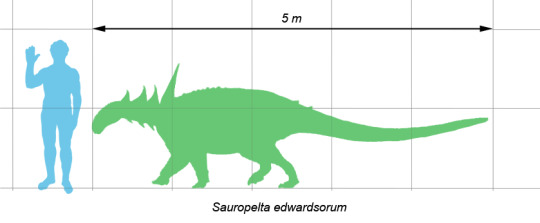
By Dino Guy 2, CC BY-SA 3.0
Sauropelta itself was about 5. 2 meters long, making it fairly average size for a Nodosaurid. It was heavily built and squat in size, giving it the general appearance of a tent. It had a triangle shaped head, with a narrow tapering snout. It had a very flat top to its head and a thick skull covered in tightly fused plates, primarily for defense. It had leaf-shaped teeth in both the lower and upper jaws, and a ridge on the inside of its mouth that supported a small beak in the front.
It had a very long tail, half the total length of the body, with bony tendons lining along it to keep it stiff. It had a very wide body, with broad hips and ribs, giving it a very round appearance when looked at head-on. It had short front limbs compared to the hind limbs, arching its back so it was highest over the hips. It had very stout feet and limbs, as well as its shoulders and pelvis, allowing for it to support a great amount of muscle mass and weight.
Sauropelta had rows of small domes - scutes - from the top of the neck to the back of the tail. Over the back and the tail there are small nodules, which separated the larger cone-shaped scutes in parallel rows. On the hips these nodules and scutes locked together into a shield. Sauropelta had large spines on the sides of the neck, increasing to a peak over the shoulders, and decreasing dramatically before stopping at the hips. Flat plates lined the tail on both sides, pointing out and decreasing in size towards the tail. The spines on the tail and neck were fused, reducing the amount of motion possible for both ends of the body.
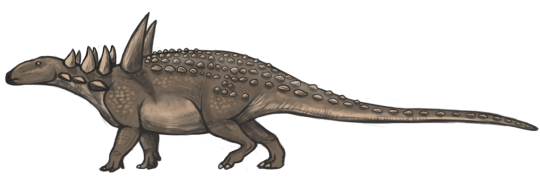
By Emily Willoughby, CC BY-SA 3.0
Diet: The small, pointed head of Sauropelta means it was a selective browser, eating very specific plant material while foraging rather than indiscriminately eating whatever plants it wanted. It would have been a low-level browser as well, given its short height and limited range of motion in the neck. So, it probably specialized in eating berries; leaves from ferns, conifers, and cycads; and other small bits of vegetation close to the ground or fallen on the ground.
Behavior: Sauropelta is a fairly common animal from its environment and possibly lived in somewhat social groups, either with a few members or many in mixed-species herds, as many other plant eating dinosaurs lived in the same location and may have associated together. It would have been somewhat slow given its squat limb proportions, as opposed to other Nodosaurids such as Hungarosaurus which specialized in quick movements and rapid turns. As such, Sauropelta would have primarily utilized its extensive armor across its back, hips, neck, and head for defense, and may have squatted down against the ground to protect its softer underbelly from attack from predators. This could also have been helped with counter-shading, as found in a close relative Sauropelta. Counter-shading is the use of natural lighting in conjunction with the color of an animal to help disguise it and hide it in the environment, and it is known in Borealopelta, another Nodosaurid; thus, it’s possible that the same would have been found in Sauropelta, or, at least, that Sauropelta would also have been a prey species that needed to hide from predators in its environment. Thus, since Sauropelta didn’t have extensive offensive structures, it probably would have been at least somewhat more skittish than aggressive.
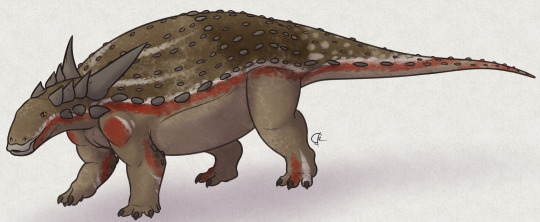
By José Carlos Cortés
As an Ankylosaur, Sauropelta had a long tongue that it could use to grab food and draw in plant materia, that it would snip off with its narrow beak and jaws. They could breathe while chewing, as well, and probably had a decent sense of smell to aid in seeking out the specific sorts of food it would have preferred.
Sauropelta would probably have taken care of its young, considering that other dinosaurs tend to do so, but there is little evidence present either way for Sauropelta.
Ecosystem: Sauropelta lived in the Cloverly Formation, an Early Cretaceous Western North America ecosystem that showcases the transition from the Late Jurassic to the Late Cretaceous in this region, with many of the features of the more famous Morrison and Hell Creek formations in a weird sort of blender in terms of types of dinosaurs present. This environment lay along the Western Interior Seaway as it began to grow through North America, and extensive rivers ran through the Cloverly Formation to drain into the ocean. These rivers would flood, causing mass burials of animals and leading to the fossils of the formation. The plains were mostly forested, covered in a variety of conifers and cycads. This would lead to flooding causing extensive damage to the forest ecosystem and, as such, leading to mass die-offs of animals.
This muddy environment transitioned to a more sandy environment, still with some mud, as it aged from the Little Sheep Member of the formation to the Himes Member. This reflected the growth of the seaway and the encroachment of beach sand towards the environment of Sauropelta and others. While many creatures died off in the transition, Sauropelta is present in both layers, indicating that it was fine with the new beachfront property.

By John Conway, CC BY-SA 3.0
In the earlier Little Sheep ecosystem, Sauropelta lived alongside dinosaurs such as the medium-level Ornithopod browser Tenontosaurus, the fast-moving low browser Zephyrosaurus, the ambush raptor predator Deinonychus, the Oviraptor omnivore Microvenator, and remains of large sauropods that have not yet been named. There were also non-dinosaurs such as the lungfish Ceratodus, the sharks Polyacrodus and Egertonodus, and many other bony fish, frogs, salamanders, and turtles like Glyptops. There were also mammals such as Gobiconodon, Oklatheridium, Paracimexomys, and Atokatheridium. Crocodilians and lizards were also frequenters of the environment, along with the dinosaurs.
The Himes ecosystem was somewhat different, but in many ways still quite similar to its earlier precursor. Deinonychus, Microvenator, and Tenontosaurus were still around, but there was also the very tall sauropod Sauroposeidon, a poorly known sauropod Rugocaudia, another Nodosaurid Tatankacephalus, and the large predator Acrocanthosaurus, which would definitely have been a thorn in Sauropelta’s side. There may have even been a proto-bird, but that is unconfirmed. There were lizards, frogs, salamanders, crocodilians and more basal crocodile relatives, turtles such as Naomichelys, and an extreme variety of fish and sharks. There were also mammals such as Gobiconodon, Argaliatherium, Corviconodon, Montalestes, Pappotherium, and a wide variety of others.
Sauropelta was an critical fixture of both of these time points, and would have been a defining sight in the Cloverly environment.
Other: Sauropelta may also be known from the Cedar Mountain Formation, a similar environment to the Cloverly, but these remains are largely unconfirmed at this time.
~ By Meig Dickson
Sources under the cut
Arbour, V. M, & P. J. Currie. 2015. Systematics, phylogeny and palaeobiogeography of the ankylosaurid dinosaurs. Journal of Systematic Palaeontology DOI: 10.1080/14772019.2015.1059985.
Brown, C. M., D. M. Henderson, J. Vinther, I. Fletcher, A. Sistiaga, J. Herrera, R. E. Summons. 2017. An Exceptionally Preserved Three-Dimensional Armored Dinosaur Reveals Insights into Coloration and Cretaceous Predator-Prey Dynamics. Current Biology 27 (16): P2514-2521.E3.
Carpenter, K. 1984. Skeletal reconstruction and life restoration of Sauropelta (Ankylosauria: Nodosauridae) from the Cretaceous of North America. Canadian Journal of Earth Sciences 21 (12): 1491 - 1498.
Carpenter, K., J. I. Kirkland. 1998. Review of Lower and Middle Cretaceous Ankylosaurs from North America. In Lucas, S. G., J. I. Kirkland, J. W. Estep. Lower and Middle Cretaceous Ecosystems: New Mexico Museum of Natural History and Science Bulletin 14: 249 - 270.
Horner, J. R. Dinosaurs Under the Big Sky (Cloverly Formation). Mountain Press Publishing Company: 93 - 100.
Kirkland, J. E., B. Britt, D. L Burge, K. Carpenter, R. Cifelli, F. DeCourten, J. Eaton, S. Hasiotis, T. Lawton. 1997. Lower to Middle Cretaceous Dinosaur faunas of the central Colorado Plateau: a key to understanding 35 million years of tectonics, sedimentology, evolution, and biogeography. Bringham Young University Geology Studies 42 (II): 69 - 103.
Kirkland, J. I., L. Alcalá, M. A. Loewen, E. Espílez, L. Mampel, J. P. Wiersma. 2013. R. J. Butler ed. The Basal Nodosaurid Ankylosaur Europleta carbonensis n. gen., n. sp. From the Lower Cretaceous (Lower Albian) Escucha Formation of Northeastern Spain. PLoS ONE 8 (12): e80405.
Mallon, J. C., D. C. Evans, M. J. Ryan, J. S. Anderson. 2013. Feeding Height stratification among the herbivorous dinosaurs from the Dinosaur Park Formation (upper Campanian) of Alberta, Canada. BMC Ecology 13: 14.
Maxwell, W. D. 1993. Neonate dinosaur remains and dinosaur eggshell from the Lower Cretaceous Cloverly Formation, Montana. Journal of Vertebrate Paleontology 13 (3): 49A.
Maxwell, D. W. 1997. Cloverly Formation. In Currie, P. J., K. Padian. The Encyclopedia of Dinosaurs. San Diego: Academic Press: 128 - 129.
Moberly, R. M. 1960. Morrison, Cloverly, and Sykes Mountain Formations, Northern Bighorn Basin, Wyoming and Montana: Geological Society of American Bulletin 71 (8): 1137 - 1176.
Oreska, M. P. J., M. T. Carrano, K. M. Dzikiewicz. 2013. Vertebrate paleontology of the Cloverly Formation (Lower Cretaceous), I: faunal composition, biogeographic relationships, and sampling. Journal of Vertebrate Paleontology 33(2):264-292.
Ostrom, J. H. 1970. Stratigraphy and paleontology of the Cloverly Formation (Lower Cretaceous) of the Bighorn Basin area, Wyoming and Montana. Peabody Museum Bulletin 35: 1 - 234.
Salgado, L., Z. Gasparini. 2006. Reappraisal of an ankylosaurian dinosaur from the Upper Cretaceous of James Ross Island (Antarctica). Geodiversities 28 (1): 119 - 135.
Vickaryous, M. K., T. Maryanska, D. B. Weishampel. 2004. Ankylosauria. In D. B. Weishampel, P. Dodson, H. Osmólska. The Dinosauria 2nd ed. Berkeley: University of California Press: 363 - 392.
U. S. Geological Survey. 1993. Geologic Unit: Cloverly.
Weishampel, D. B., P. Dodson, H. Osmólska (eds.): The Dinosauria, 2nd edition, Berkeley: University of California Press.
#sauropelta#sauropelta edwardsorum#dinosaur#nodosaurid#palaeoblr#factfile#dinosaurs#prehistoric life#prehistory#paleontology#herbivore#cretaceous#north america#ankylosaur#mesozoic monday#biology#a dinosaur a day#a-dinosaur-a-day#dinosaur of the day#dinosaur-of-the-day#science#nature
242 notes
·
View notes
Text
Cercibis oxycerca
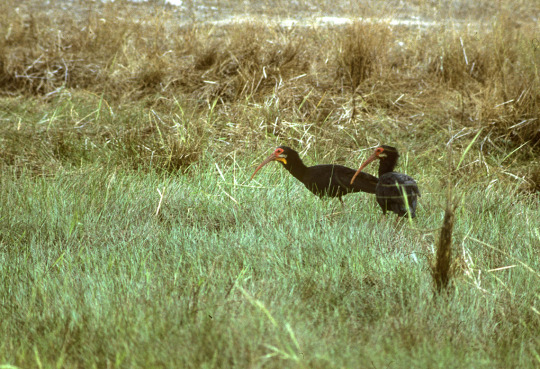
By Francesco Veronesi, CC BY-SA 2.0
Etymology: Tailed Ibis
First Described By: Wagler, 1832
Classification: Dinosauromorpha, Dinosauriformes, Dracohors, Dinosauria, Saurischia, Eusaurischia, Theropoda, Neotheropoda, Averostra, Tetanurae, Orionides, Avetheropoda, Coelurosauria, Tyrannoraptora, Maniraptoromorpha, Maniraptoriformes, Maniraptora, Pennaraptora, Paraves, Eumaniraptora, Averaptora, Avialae, Euavialae, Avebrevicauda, Pygostaylia, Ornithothoraces, Euornithes, Ornithuromorpha, Ornithurae, Neornithes, Neognathae, Neoaves, Aequorlitornithes, Ardeae, Aequornithes, Pelecaniformes, Threskiornithidae, Threskinornithinae
Status: Extant, Least Concern
Time and Place: Within the last 10,000 years, in the Holocene of the Quaternary

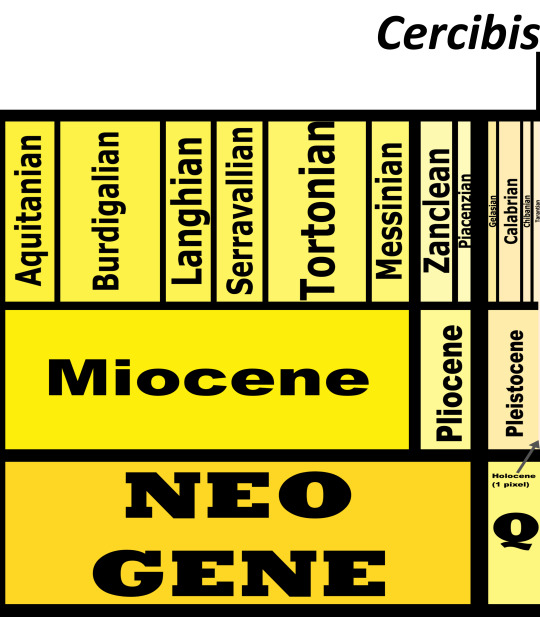
Cercibis is known primarily from wet lowlands and riverbanks in northern South America
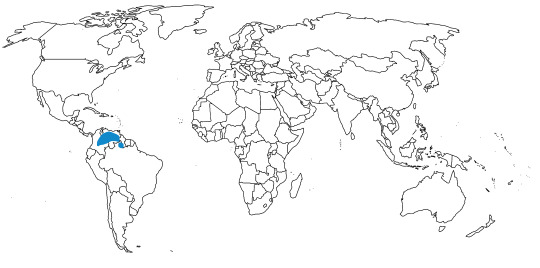
Physical Description: Cercibis, the Sharp-Tailed Ibis, is a large, black wading bird with the distinctive long pointy snout of the Ibises. It is about 75 to 86 centimeters long, making it about the same length as a small Canada Goose. Their bodies are entirely black in color, and they have long brown legs, reddish faces, and beige beaks. The beaks are very long and downward pointed, like those of most ibises, with long slit-like nostrils extending from the top of the beak down. It has the longest tail of any ibis, which might be the source of its unusual name. The black feathers are tinted green in most locations, and purple on the back, hind neck, wings, and tail. Juveniles aren’t as shiny as the adults.
Diet: The Sharp-Tailed Ibis primarily feeds on small invertebrates, especially insects, earthworms, crustaceans, and snails. They’ve also been found eating small aquatic vertebrates such as amphibians. It is less aquatic than other Ibises in its feeding habits. It’s primary food source is, however, insects, above all other groups.
Behavior: The Sharp-Tailed Ibis forages primarily in small groups, or mated pairs, in open land and tall grass environments, sifting through shallow mud for insects, as well as along the edges of lagoons. They will occasionally forage for insects in shallow water, less than 3 centimeters deep. They walk quickly along the mud and probe deep into the ground looking for prey, using touch to find it in the ground. They don’t particularly mind the mud and can often be found with it dried along their bills. It is mostly active in the morning, unlike other ibises in the region with similar feeding habits.
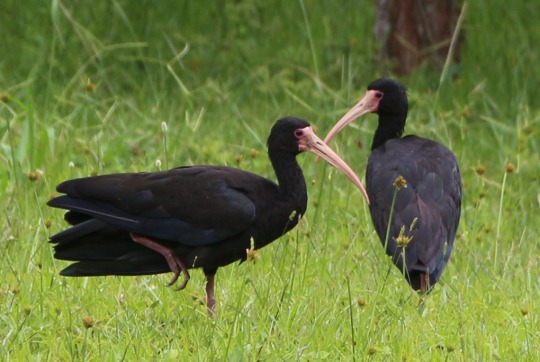
By Miguel Jacques, in the Public Domain
The Sharp-Tailed Ibis does migrate some during the wet season, going to higher elevations to escape the flooding of their usual lowland grass habitat. These higher regions remain unflooded and, thus, filled with their preferred foraging areas. Other than that, though, they remain largely sedentary, not migrating over large distances for food. They fly extremely slowly, and low above the ground, only covering short distances. Sometimes they do fly over larger areas to reach roosting and feeding sites, but they are very loud fliers and easily spotted via hearing before they come into sight. They walk very slowly and carefully, and in general aren’t the fastest of animals.
The Sharp-Tailed Ibis is an extremely vocal bird, making loud trumpeting calls that are repeated extensively. While perched, they make similar but shorter calls, as well as quiet low grunts. They also make loud, drawn-out flight calls. The drumming sound of the calls lead to their common name in Spanish being Tarotaro.
This particular ibis breeds during the dry season, from August until February, which is very weird for an ibis as most breed during the wet season. They breed in forests in monogamous pairs, and egg laying occurs in August and September. The young will stay with their parents all the way through the end of the dry season. Courtship behavior isn’t known, but it seems that preening each other is a part of it, and they also preen their offspring.
Ecosystem: The Sharp-Tailed Ibis mainly lives in lowland wetland habitats as well as along lagoons and in tall grass environments. They do migrate a little back and forth from higher elevations to lower elevations depending on wetland flooding. They are primarily preyed upon by the Black-Collared Hawk, which will pursue these ibises over flooded marshes which often leads to the ibis actually moving fast for once.
Other: This ibis has never been kept in captivity, nor imported out of South America. Despite its smaller habitat, it is an extremely stable bird and does not seem to be in danger of extinction.
~ By Meig Dickson
Sources under the cut
Aguilera, E. 1988. La comunidad de ibises (Threskiornithidae) en los Llanos de Venezuela. Sociedad de Ciencias Naturales La Salle. 130.
Blake, E. R. 1977. Manual of Neotropical Birds. Vol. 1. University of Chicago Press, Chicago.
Byers, O., K. Brouwer, M. Coulter, U. S. Seal. 1995. Stork, Ibis, and Spoonbill Conservation Assignment Management Plan: Working Document. IUCN/SSC Conservation Breeding Specialist Group: Apple Valley, MN.
Frederick, P. C., K. L. Bildstein. 1992. Foraging ecology of seven species of Neotropical ibises (Threskiornithidae) during the dry season in the Llanos of Venezuela. The Wilson Bulletin 104: 1 - 21.
Kushlan, J. A., G. Morales, P. C. Frohring. 1985. Foraging niche relations of wading birds in tropical wet savannas. Ornithological Monographs 36: 663 - 682.
Jobling, J. A. 2010. The Helm Dictionary of Scientific Bird Names. Christopher Helm Publishing, A&C Black Publishers Ltd, London.
Luthin, C. S. 1983. Breeding ecology of Neotropical ibises in Venezuela and comments on captive propagation. Proceedings Jean Delacour/IFCB Symposium on Breeding Birds in Captivity. INternational Foundation for the Conservation of Birds, Hollywood, California.
Matheu, E., del Hoyo, J., Garcia, E.F.J. & Boesman, P. (2019). Sharp-tailed Ibis (Cercibis oxycerca). In: del Hoyo, J., Elliott, A., Sargatal, J., Christie, D.A. & de Juana, E. (eds.). Handbook of the Birds of the World Alive. Lynx Edicions, Barcelona.
Morton, E. S. 1979. A comparative survey of avian social systems in northern Venezuelan habitats. Pgs. 233 - 259 in Eisenberg, J. F. Vertebrate Ecology of the Northern Neotropics. Smithsonian Institution Press, Washington D. C.
Ogden, J. C., B. T. Thomas. 1985. A colonial wading bird survey in the central Llanos of Venezuela. Colonial Waterbirds 8: 23 - 31.
Schönwetter, M. 1967. Handbuch der Oologie (W. Meise, ed.) Band I. Akademie - Verlag, Berlin.
Thomas, B. T. 1979. The birds of a ranch in the Venezuelan Llanos. Pgs. 213 - 232 in Eisenberg, J. F. Vertebrate Ecology of the Northern Neotropics. Smithsonian Institution Press, Washington D. C.
Van Perlo, B. 2009. A Field Guide to the Birds of Brazil. OUP USA, First Edition.
#crcibis#sharp-tailed ibis#bird#ibis#dinosaur#birds#dinosaurs#cercibis oxycerca#ardeaen#Aequorlitornithian#water wednesday#south america#quaternary#insectivore#birblr#biology#a dinosaur a day#a-dinosaur-a-day#dinosaur of the day#dinosaur-of-the-day#science#nature#factfile
83 notes
·
View notes